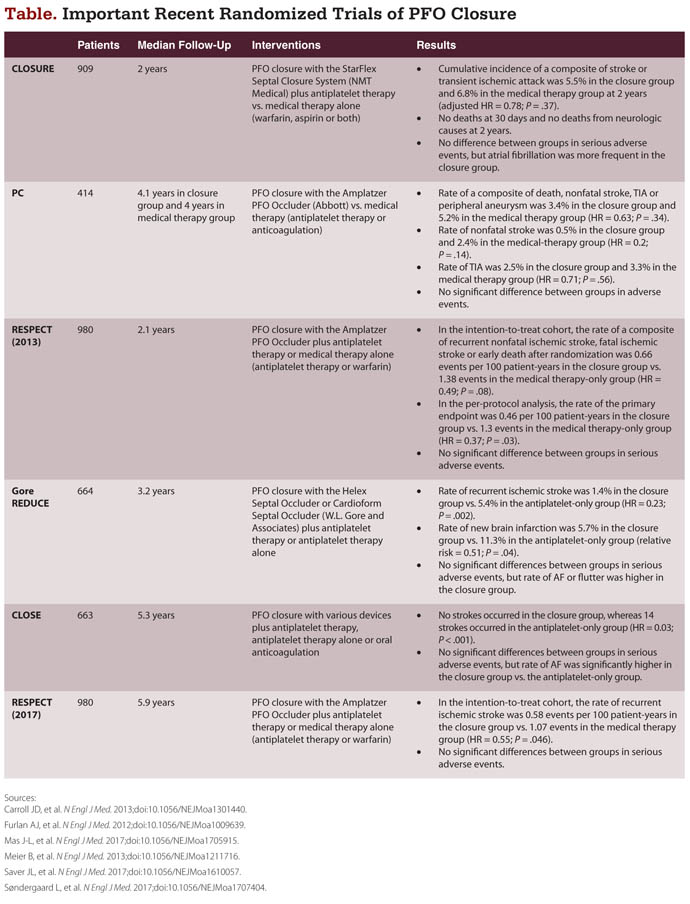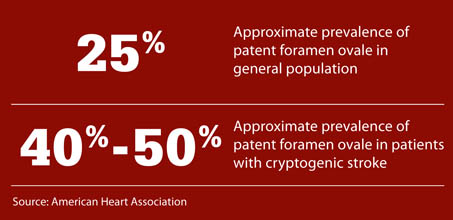PFO Closure Re-emerging
A firm evidence base now supports patent foramen ovale closure for secondary stroke prevention.

Because the benefits of patent foramen ovale closure were once in question, physicians remain hesitant about its use in clinical practice. Recent data, however, have confirmed the safety and efficacy of PFO closure for secondary stroke prevention and experts are now encouraging their colleagues to consider PFO closure in certain patients.
“The potential for paradoxical embolism is an acknowledged risk of having a PFO. Nobody will argue that it’s not possible for a clot from the venous system to pass through a PFO and wind up in the brain or coronary arteries, which can be fatal,” Bernhard Meier, MD, senior consultant in the department of cardiology at the University Hospital of Bern in Switzerland, told Cardiology Today’s Intervention. “The PFO is a potential killer and PFO closure is a simple, quick intervention, so, by all means, close a PFO that you know of before it does harm again.”
Nevertheless, cardiologists and neurologists who care for patients with PFO who have experienced a stroke must still approach these patients with caution, according to John D. Carroll, MD, professor of medicine and director of interventional cardiology at the University of Colorado School of Medicine. For instance, PFO is often an incidental finding in patients who have competing causes of stroke, such as cerebrovascular disease or atrial fibrillation. In these patients, he noted, there may be little advantage to PFO closure.

“It’s all about selecting the right patients, working with neurologists to identify such patients, and then performing a safe, effective procedure that should rarely have any major or serious complications and brings significant benefit to these patients,” Carroll said in an interview.
Recent Clinical Trials Provide ‘Clear Evidence’
From 2012 to 2013, three randomized clinical trials — CLOSURE I, RESPECT and PC — published in The New England Journal of Medicine cast doubt on the efficacy of PFO closure, with all three studies suggesting that the procedure was no more beneficial than medical therapy for prevention of recurrent stroke (Table).

In 2017, however, two new randomized trials — CLOSE and Gore REDUCE — and an extended follow-up study of RESPECT, all also published in NEJM, offered a different picture of PFO closure (Table).
In the CLOSE and Gore REDUCE trials, PFO closure plus long-term antiplatelet therapy, compared with antiplatelet therapy alone, was associated with 97% and 77% reductions in risk for ischemic stroke, respectively. The new analysis of RESPECT, which extended follow-up from a median of 2.1 to 5.9 years, also linked PFO closure to a significant 45% reduction in risk for ischemic stroke compared with antiplatelet therapy alone. PFO closure was associated with a small increase in paroxysmal AF in CLOSE and Gore REDUCE, but overall procedure- and device-related complication rates were low.
All three studies included recurrent ischemic stroke in the primary composite endpoint and enrolled similar patients: adults aged younger than 60 years with a PFO who experienced cryptogenic ischemic strokes.
However, device selection differed among the trials. Operators used the Amplatzer PFO Occluder (Abbott) in RESPECT and the Helex Septal Occluder, which is no longer available, and Cardioform Septal Occluder (W.L. Gore and Associates) in the Gore REDUCE trial.

In CLOSE, 11 different devices were used, with the most popular being the Amplatzer PFO or Multifenestrated “Cribriform” Septal Occluder (Abbott), the Intrasept PFO Occluder (Cardia), the Premere (Abbott, no longer available), the Starflex Septal Occluder System (NMT Medical), and the Figulla Flex II PFO Occluder (Occlutech).
“Presently, PFO closure is underutilized because of the prior controversy and lack of definitiveness, but now we have clear evidence from multiple clinical trials that it does in fact work and is superior to taking antiplatelet therapy alone,” Carroll told Cardiology Today’s Intervention.
PFO and Stroke Risk
With PFO being fairly common — affecting approximately 20% to 25% of the general adult population — the decision to pursue treatment hinges on the danger posed by the PFO, experts told Cardiology Today’s Intervention.
“No study has demonstrated an increased risk for first stroke in patients with PFO. There certainly may be an increased risk, but given how prevalent PFO is, the risk is likely very low,” Steven R. Messé, MD, associate professor of neurology at the Hospital of the University of Pennsylvania, wrote in an email to Cardiology Today’s Intervention.
Indeed, the vast majority of people with PFO never have a stroke, but the risk should not be dismissed, Carroll said.

“PFO is not a major cause of stroke, although it is not an insignificant cause of stroke, especially in people younger than 60, where it is a significant stroke mechanism that needs to be considered,” he said.
A variety of other factors may also contribute to stroke risk in this patient population.
“For example, the risk for stroke in a person with PFO is higher if the shunt is very large or if atrial septal aneurysm is present and if the patient has a higher likelihood of developing blood clots, such as women on oral contraceptives or hormone replacement therapy for menopause,” Jonathan M. Tobis, MD, MSCAI, professor of medicine and interventional cardiology at the UCLA David Geffen School of Medicine, said in an interview.
The evidence is clearer for recurrent stroke, according to Lars Søndergaard, MD, DMSc, professor of cardiology at the Heart Center Rigshopitalet in Copenhagen, Denmark. Specifically, the prevalence of PFO is higher in patients who have had a cryptogenic ischemic stroke and results from the recent clinical trials showed that PFO closure plus antiplatelet therapy reduces the risk for recurrent stroke, he wrote in an email to Cardiology Today’s Intervention.
Meier said he suspects, however, that the stroke risk associated with PFO is largely underestimated. He said that the oft-quoted estimated lifetime risk for stroke in people with PFO who have not already had a stroke is 2% to 3%. That percentage, though, has not been proven definitively and is likely much higher, he explained.
One reason why the estimated risk is so low, according to Meier, is the fact that physicians only identify PFO as the culprit after ruling out other causes of stroke such as atherosclerosis or arrhythmia.
The Decision to Treat
When confronted with a patient with a PFO who has had a cryptogenic stroke, the general consensus among clinicians is that they should look to the most recent data to determine which patients may be best suited for PFO closure, experts told Cardiology Today’s Intervention.
“We should try to recapitulate what was used to select patients in the positive PFO closure trials. So, generally healthy patients younger than 60 who have had an embolic-appearing stroke and no other plausible mechanism after a complete work-up,” Messé said. It is reasonable, however, to consider PFO closure in some patients who do not fit these criteria, such as those aged 60 to 65 with limited vascular factors that would lead to atherosclerosis or those younger than 30 with a small, deep stroke and no family history of early stroke suggestive of a genetic mechanism, he said.
Meier noted that the procedure is particularly beneficial in younger patients.
“The risk for recurrent stroke in people whose PFO is determined to be the cause of their index stroke is about 1% per year. Therefore, if a person still has a life expectancy of 30 years after their first stroke, his or her lifetime risk for another stroke is 30%, which is considerable,” he said.
Other factors may also tip the scales in favor of PFO closure in patients, according to Meier. Chief among them, he said, is the PFO itself.
“It is unlikely, for example, that a clot will find its way through a small PFO that only opens maybe once a month for a second. Therefore, that PFO may not require closure. However, let’s say a person has a PFO with an atrial septal aneurysm that is so mobile that it is like a curtain covering an open window, blowing open for a half second with every heartbeat. In that case, the PFO should be closed, as it is very likely that a clot will pass through the PFO at some point because it is essentially open all the time,” Meier told Cardiology Today’s Intervention.
Although which patients should be considered for the procedure may be up for debate, there are fewer concerns about which patients should not undergo PFO closure after evaluation by a neurologist and cardiologist.

“There are certain factors that may change the technical difficulty of performing PFO closure, but it’s rare to find a certain contraindication to PFO closure in someone who’s had a stroke that was likely due to a paradoxical embolism through a PFO,” Carroll said.
Even in the typical subgroups that present concerns with this type of intervention, such as those with autoimmune disease, inflammatory disease, hypercoagulability or a higher risk for infection, have not appeared to fare worse with PFO closure than those without these issues, according to Tobis.
“We published a study looking at our patients who underwent PFO and there were 24 patients with inflammatory diseases or a higher risk for infection because they’re immunocompromised patients with cancer,” he said. “We had no problems with any of those patients — no infection, no rejection and no device erosion. Granted, it’s a small number, but all of those patients are excluded from randomized trials, so it’s hard to get good data on that subpopulation.”
Tobis noted, however, that although the risk for complications is low, it is not nonexistent. In a study published in 2011 in JACC: Cardiovascular Interventions, he and his colleagues found that an estimated one in 500 patients implanted with a PFO closure device may experience a significant problem that necessitates device removal. Patients should be warned about this risk before treatment, he said.
In considering these issues, according to Søndergaard, it is important to bear in mind that the decision to treat requires input from a number of people.
“Selection of patients with cryptogenic stroke who should be offered PFO closure is a multidisciplinary decision that involves a stroke neurologist, an imaging specialist and an interventional cardiologist,” he said.
Device Selection
In 1997, Meier, together with inventor Kurt Amplatz, MD, implanted the first dedicated PFO closure device — the Amplatzer PFO Occluder.
Since then, about 20 other devices have come onto the market, according to Meier. Approximately 10 of them are similar to the Amplatzer device, especially now that the patent has expired, he said.
In the United States, however, only the Amplatzer PFO Occluder and the Cardioform device have been approved by the FDA. The devices are mostly comparable, with both having high closure rates — approximately 85% and 70%, respectively — and low overall complication rates, experts told Cardiology Today’s Intervention.
Both devices also have drawbacks, with Cardioform being associated with a slightly higher risk for AF and a higher risk for wire fracture with possible perforation and Amplatzer being associated with more device erosion, according to Tobis. Meier noted, though, that the increased erosion rate with Amplatzer may be a false impression due to the fact that it has been implanted in significantly more patients compared with Cardioform.
One notable difference is less nickel exposure with the Cardioform device, which potentially makes it a more suitable option for patients with nickel allergies. Nevertheless, Meier said he had implanted the Amplatzer device in people with nickel sensitivities and has not experienced any significant problems. Tobis said he is more wary of the Amplatzer products in someone who describes a history of nickel allergy.
Consequently, all things considered, device selection boils down to operator preference, according to experts who spoke with Cardiology Today’s Intervention. Tobis noted that he prefers the Cardioform device because it is softer and more flexible, whereas Meier said he prefers the Amplatzer, citing its higher closure rate and absent risk for wire fracture.
Carroll, on the other hand, said he is open to using either device.
Other technologies for PFO closure also exist, including a percutaneous suture-based system (NobleStitch EL, HeartStitch). Previous results indicated that the device was not effective, but an Italian registry study published in EuroIntervention in 2018 showed that PFO closure with the system was feasible and that the technology was comparable to traditional devices in terms of safety and efficacy.
Meier, however, remains skeptical. The technique only employs one stitch, which would likely not be enough to fully close the PFO long-term, and the procedure is also much longer and more complicated, compared with implanting one of the other devices, he said.
Future Considerations
Although uptake of PFO closure still has room to increase, experts told Cardiology Today’s Intervention that, in light of the second round of trials, they feel the question about the benefit of the procedure in terms of secondary stroke prevention has mostly been answered.
The new results from Gore REDUCE, CLOSE and RESPECT have also nudged societies and associations toward including PFO closure in their recommendations. For instance, an inter-society European position paper on the management of patients with PFO outlines a multidisciplinary approach to diagnosis and treatment of PFO.

“Both the Canadian and German guidelines now list PFO closure plus antiplatelet therapy in carefully selected patients with a cryptogenic stroke as a class 1A recommendation, whereas others, including those from the American Academy of Neurology, have yet to be updated,” Søndergaard said.
Similarly, The BMJ published a clinical practice guideline in 2018 that states that PFO closure plus antiplatelet therapy is preferable to antiplatelet therapy alone.
Because these recommendations are based on the existing research, though, they only apply to younger patients whose stroke is deemed attributable to the PFO after exclusion of all other causes.
“One major question is whether PFO closure is indicated in patients older than 60 years of age,” Søndergaard said. “Although these patients were not included in the trials, it may be clinically relevant to consider closure in the case of cryptogenic stroke. However, it is uncertain whether new trials on PFO closure in these elderly patients will be initiated. This is due to the predicted difficulties with enrollment since these patients are likely to seek ‘off-label’ PFO closure outside trials.”

Messé added that studies of anticoagulation vs. closure, particularly in these older patients would be informative, as would trials comparing aspirin with anticoagulation in this population.
Finally, prophylactic PFO closure before a first event is neither an active area of investigation nor a widely accepted concept, with most clinicians taking a very conservative stance, but Meier believes that it is worth being proactive in patients with PFOs of the dangerous kind or other predispositions.
“For PFO carriers, undergoing PFO closure means lifelong protection from the potential harm the PFO could cause while doing everyday things,” he told Cardiology Today’s Intervention. “If you’re a diver, a mountain climber, a brass musician, a glass blower or a tile layer, your PFO opens more frequently. PFO closure would ensure that you’re safer while practicing your hobbies or in your profession.”
After all, Meier added, the procedure is quick and remarkably easy for the operator and the patient.
“If you can prevent a stroke using such a simple intervention, then why not do it?” he said. – by Melissa Foster
- References:
- American Heart Association. https://www.heart.org/en/health-topics/congenital-heart-defects/about-congenital-heart-defects/patent-foramen-ovale-pfo. Accessed March 5, 2019.
- Carroll JD, et al. N Engl J Med. 2013;doi:10.1056/NEJMoa1301440.
- Furlan AJ, et al. N Engl J Med. 2012;doi:10.1056/NEJMoa1009639.
- Gaspardone A, et al. EuroIntervention. 2018;doi:10.4244/EIJ-D-18-00023.
- Kuijpers T, et al. BMJ. 2018;doi:10.1136/bmj.k2515.
- Mas J-L, et al. N Engl J Med. 2017;doi:10.1056/NEJMoa1705915.
- Meier B, et al. N Engl J Med. 2013;doi:10.1056/NEJMoa1211716.
- Pristipino C, et al. Eur Heart J. 2018;doi:10.1093/eurheartj/ehy649.
- Saver JL, et al. N Engl J Med. 2017;doi:10.1056/NEJMoa1610057.
- Søndergaard L, et al. N Engl J Med. 2017;doi:10.1056/NEJMoa1707404.
- Verma SK, et al. JACC Cardiovasc Interv. 2011;doi:10.1016/j.jcin.2011.01.009.
- For more information:
- John D. Carroll, MD, can be reached at john.carroll@ucdenver.edu.
- Bernhard Meier, MD, can be reached at bernhard.meier@insel.ch.
- Steven R. Messé, MD, can be reached at messe@pennmedicine.upenn.edu.
- Lars Søndergaard, MD, DMSc, can be reached at lars.soendergaard.01@regionh.dk.
- Jonathan M. Tobis, MD, MSCAI, can be reached at jtobis@mednet.ucla.edu.
Disclosures: Carroll reports he has served on the steering committee of the RESPECT trial and he has received compensation for services related to that role from the study sponsors (Abbott Vascular, AGA Medical and St. Jude Medical). Meier reports he is on the speakers bureau and is a proctor for Abbott. Messé reports he was a local subinvestigator for the CLOSURE I trial and a local primary investigator for the Gore REDUCE trial and he receives research funding from W.L. Gore and Associates for a study of neurologic outcomes from aortic disease. Søndergaard reports he is a national principal investigator for the Gore REDUCE trial and he was compensated for his time by the W.L. Gore and Associates. Tobis reports he is a proctor for Abbott Vascular and W.L. Gore and Associates.
View related article entitled, "PFO Closure for Migraine Relief."
